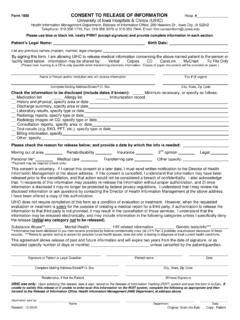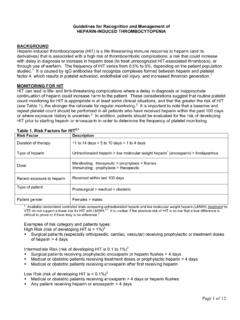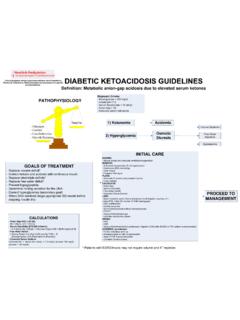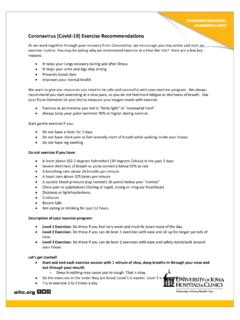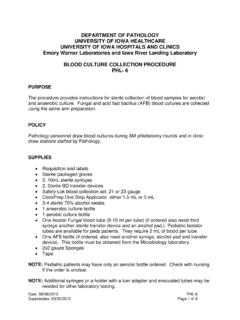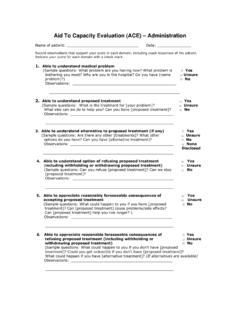Transcription of Recommended Antimicrobial Dosage Schedules for Neonates
1 Recommended Antimicrobial Dosage Schedules for Neonates Meghan Mentink, PharmD, BCPPS; Hailey Steuber, PharmD, BCPPS; Sarah Tierney, PharmD, BCPPS; Jennifer Vejzovic, PharmD, BCPPS Updated June 2020 Drug Dosage Major Indications/Remarks Acyclovir 20mg/kg/dose q 8 h IV administered over 1 hour In severe cases, will follow with 300mg/m2/dose PO q 8 h x 6 months Herpes Simplex encephalitis Monitor LFTs and renal function (ie. SCr and UOP) Treat localized infection for 14 days, disseminated or CNS infections for 21 days. Amikacin* Give IV or IM PMA (weeks) Postnatal (days) Dose (mg/kg) Interval (hrs) 29 0 to 7 8 to 28 29 14 12 12 48 36 24 30 to 34 0 to 7 8 12 12 36 24 35 ALL 12 24 Administer over 30 minutes. Gram negative enteric bacteria.
2 Usually used in combination with a beta-lactam antibiotic. Peak 20-30 (drawn 30 minutes after end of infusion), Trough < 8 mcg/mL Amoxicillin 20mg/kg/dose PO qhs UTI prophylaxis. Do not administer at the same time as probiotics Amphotericin B Conventional 1mg/kg IV q24hr Administer over 4 hours **Interaction with NS! No NVN or NS can be given at the same time!!** Recommend to flush with D5W. Only information to support compatibility with D5W and D10W Most systemic fungal infections and severe superficial mycoses. Note SIGNIFICANT dosing difference between conventional and lipid complex dosing. Infuse over 4 hours. Administer through a central line. Do not premed or fluid bolus before. ADR: nephrotoxicity (Decreases renal blood flow/GFR), infusion-related (fever, rigors), hypokalemia, hypomagnesemia.
3 Note: In Neonates , lipid formulations of amphotericin have limited penetration into the central nervous system, kidneys, urinary tract, and eyes than conventional amphotericin and are not preferred in most cases Ampicillin 100mg/kg/dose IV 29 wks PMA: q12h ( 28d), q8h (>28d) 30-34 wks PMA: q12h( 14d), q8h (>14d) 35 wks PMA: q8h 45 wks PMA: q6h Ampicillin for GBS Meningitis: 300 mg/kg/day IV divided Q8h ( 7d) or Q6h (>8d) Used empirically for neonatal sepsis to cover for GBS, listeria, enterococcus. Providers in Newborn Nursery may choose to use Ampicillin 75 mg/kg q8h in Neonates with 35 wks PMA without concern for meningitis Normal IV concentration: 100mg/ml IM concentration: 333mg/ml In the presence of GBS sepsis and the treatment with ampicillin or PenG, the bacteria will release a phospholipid that can cause pulmonary hypertension.
4 Goal is to start empiric antibiotics within 60 minutes of birth as bacteria double every 20 minutes. Caspofungin 25mg/m2 (or approximately 2mg/kg) IV per dose q 24 hours Administer over 1 hour Max. concentration of diluted in NS. Antifungal agent for refractory Candida or invasive Aspergillosis refractory or intolerant to other therapies. Antifungal of choice in systemic peritoneal fungal sepsis. Thrombocytopenia often seen in the presence of peritoneal fungal sepsis Incompatible with D5W. If infused with other drips, make sure they are prepared in NS. Flush with NS only Cefazolin 25 mg/kg slow IV push or IM* <29 wks PMA: q12h(<28d), q8h (>28d) 30-36 wks PMA: q12h(<14d), q8h (>14d) 37-44 wks PMA: q12h(<7d), q8h (>7d) >45 wks PMA: q8h *Use 30 mg/kg with surgical situation and 25 mg/kg all other times Adjust dosing frequency in renal insufficiency: 1st generation cephalosporin Gram + cocci (staph aureus); may cause false positive urine reducing substance.
5 Poor CNS penetration. Cefepime 50mg/kg/ IV q12h or q8h Adjust dosing frequency in renal insufficiency: 4th generation cephalosporin. Q8h dosing for meningitis. No anaerobic coverage. Preferred over gentamicin in cases with HIE N=1 have observed hypertension, seizure-like, dystonic activity when cefepime was given intraperitoneal in PD fluid while also receiving Zosyn. This would be consistent with the potential ADR of lowering seizure-threshold with double beta-lactam therapy. Cefotaxime 50 mg/kg/dose IV or IM <32 wks PMA: q12h (<7d), q8h (>7d) >32 wks PMA: q12h (<7d), q8h (>7d) Meningitis: 50 mg/kg IV <7 days: 100 to 150 mg/kg/day IV divided every 8 to 12 hours. 3rd Generation; Treatment of gram negative enteric bacteria. Penetrates well across BBB and good for use in meningitis.
6 Hepatically metabolized. Preferred agent in HIE Often on drug shortage and obtained from Canada. Check inventory before dispensing. >7 days: 150 to 200 mg/kg/day IV divided every 6 to 8 hours Administer of 30 minutes Adjust dosing frequency in renal insufficiency: Cefoxtin 30-33mg/kg/dose IV or IM q8h Administer IV over 30 minutes Adjust dosing frequency in renal insufficiency: 2nd generation cephalosporin. Enhanced activity against anaerobic bacteria. Poor CNS penetration. Treatment usually limited to skin, intra-abdominal and urinary tract infections. Ceftazidime 30mg/kg IV or IM 29 wks PMA: q12h ( 28d), q8h (>28d) 30-36 wks PMA: q12h ( 14d), q8h (>14d) 37-44 wks PMA: q12h ( 7d), q8h (>7d) 45 wks PMA: q8h Meningitis: 7d: 100-150 mg/kg/day IV divided q8-12h >7d: 150 mg/kg/day IV divided q8h Adjust dosing frequency in renal insufficiency: 3rd generation cephalosporin.
7 Gram negative converage, especially pseudomonas. Consider double coverage when positive pseudomonas cultures. Synergistic with aminoglycosides. Ceftriaxone DO NOT USE IN Neonates For infants >28 days: Sepsis/Disseminated gonococcal infections: 50mg/kg q 24 h IV or IM Meningitis: 100mg/kg/day IV divided q12h Uncomplicated gonococcal ophthalmia: 50mg/kg once IV or IM. Administer IV over 30 minutes 3rd generation cephalosporin Concomitant use of ceftriaxone and IV calcium-containing (NVN) products at any time during the course of therapy is contraindicated in Neonates ( 28d) Cephalexin No neonatal dosing available Treatment for skin/soft tissue infections (MSSA infections): 50 mg/kg/day divided q6-8 hours UT Prophylaxis: 10-20 mg/kg/dose PO QHS 1st generation cephalosporin Can alternate with or change to Bactrim at 2 months of life for UTI prophylaxis Clindamycin 5 to IV, PO Administer IV over 30 minutes <29 wks PMA: q12h(<28d), q8h (>28d) 30-36 wks PMA: q12h(<14d), q8h (>14d) 37-44 wks PMA: q12h(<7d), q8h (>7d) >45 wks PMA.
8 Q6h Gram positive cocci (group A streptococcus, staph) and anaerobic coverage (bacteroides). Widely distributes to most tissues, especially the lungs. Poor CSF penetration. Pseudomembranous colitis most serious adverse effect (bloody diarrhea, fever) Metronidazole preferred in NEC w/ pneumatosis Fluconazole Prophylaxis for 24 weeks: 3 mg/kg Q72 hours Treatment Treatment of systemic fungal infections. If on fluconazole nystatin is not needed. However, may choose to use BOTH 12 mg/kg LD, then 6 mg/kg IV <29 wks PMA: q48h(<14d), q24h (>14d) 30-36 wks PMA: q48h(<7d), q24h (>7d) 25 mg/kg LD, then 12 mg/kg IV* 37-44 wks PMA: q48h(<7d), q24h (>7d) >45 wks PMA: q24h *Higher loading dose should not be used when SCr>1 Thrush 6 mg/kg LD, then 3 mg/kg PO qd fluconazole prophylaxis and nystatin for Neonates < 24 weeks GA.
9 IV doses 6 mg/kg ( loading doses) should infuse over 2 hours while other doses can infuse over 1 hour. Monitor hepatic function with long courses. Monitor phenobarbital and phenytoin levels as fluconazole can increase levels. Rifampin decreases fluconazole. Fluconazole distributes widely into body tissues and fluids. Avoid use with azithromycin due to increased risk of QT prolongation. Recommend discontinuing azithromycin while on fluconazole For uncomplicated candidemia, length of therapy should be 21 days after microbiological cultures are clear. If cultures are positive by Day 7, the addition of a second agent should be considered. Ganciclovir 6mg/kg/dose q 12 h IV Treat for a minimum of 6 weeks if possible Length of therapy is usually 6 months of total therapy for CMV (IV + PO) Treatment for CMV Infection Ganciclovir has the potential to improve or prevent hearing loss and improve cognitive development in the long term.
10 Monitoring: Baseline CBC with differential Weekly for 6 weeks Again at 8 weeks Then monthly until treatment course is complete (likely 6 months) due to possible neutropenia associated with therapy. Consider SCr on same monitoring schedule as CBC to monitor for chance of renal impairment with therapy. If SCr is stable on ganciclovir and no other renal issues can stop checking creatinine after a few weeks. Obtain baseline hearing screen due to possible sensorineural hearing loss with CMV infection Dose Adjustments for ANC Drop If ANC drops below 500, hold the dose until ANC reaches 750 and restart at full dose If ANC drops below 500 again, give dose until ANC reaches 750 then increase back to full dose If ANC drops below 500 again, consider discontinuation of therapy Gentamicin* <29 wks PMA: 5 mg/kg IV q48 (<7d) 4 mg/kg IV q36h (8-28d), q24h (>28d) 30-34 wks PMA: mg/kg IV q36 h(<7d) 4 mg/kg IV q24h (>7d) >35 wks PMA: 4 mg/kg IV q24h For GI overgrowth: PO: 10-20 mg/kg/day divided every 6-8 hours.
